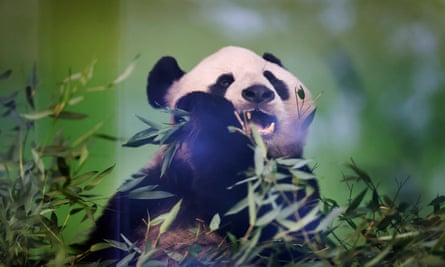As soon as she heard that Edinburgh’s pandas were about to be flown home, Sarah Greenwood knew she had to see them. “I love everything about pandas,” she said. “I absolutely couldn’t miss it.”
Wrapped in a thick coat and hat to guard against the freezing temperatures and the first snow flurries of winter, Greenwood, an events manager, 52, travelled from Cambridge on Wednesday to watch Tian Tian and her partner, Yang Guang, grazing on bamboo, sleeping and exercising.
She is not alone: the news that the only pandas in the UK are leaving after 12 years as Edinburgh zoo’s most charismatic residents, drew visitors from across the UK. Long queues have formed at weekends; scuffles even broke out as visitors wrestled for space against the glass windows of the separate feeding rooms for the animals.
“I’ve been desperately trying to get here to see them,” Greenwood said. “It’s been a really tough year and a particularly tough month. And in the end, I was just like: ‘I have to go. I don’t care. I’m going’.”
Alongside Greenwood were several dozen other people, including Chinese students, a family from Fife, and three young women from Edinburgh, who work together at the Odeon cinema. The trio were brought to the zoo by Katie Cheung, 19, who said she had seen the pandas “a tonne of times” since they arrived in Edinburgh in 2011 to febrile hype and a welcoming party that included Scotland’s then deputy first minister, Nicola Sturgeon, and a host of Chinese dignitaries. Their arrival came at the same time as a series of new Anglo-Chinese trade deals.
“I made them come with me,” Cheung said, gesturing to her two giggling friends. “They’re just so cute and cuddly … and cute,” she added, to further laughter.
The pandas’ residency in Edinburgh will come to an end very quietly in a few days. They will soon be flown home without fanfare, leaving behind a continuing dispute about the purpose of zoos and the ethics of China’s panda diplomacy.

Will Travers, director of the wildlife conservation charity Born Free and a leading critic of zoos, regards the entire episode as “sordid”. The pandas’ residency in Edinburgh has been an “unmitigated failure”.
Tian Tian and Yang Guang arrived months after it emerged Edinburgh zoo was in financial crisis. All eight breeding attempts failed, including one natural coupling, and artificial insemination using Yang Guang’s sperm and frozen sperm from other pandas. The zoo hyped up Tian Tian’s early fertility windows to garner publicity. Its shop was remodelled to accommodate panda merchandise.
Travers estimates that in all, the zoo spent roughly £13.7m on the pair. It paid China a $1m (£791,000) annual fee for first 10 years and $500,000 for the final two; £3m went on building an expansive new enclosure; there were medical costs, a constant diet of homegrown bamboo that cost £2.4m; at least £1.2m on keepers’ wages, and more on insurance.
Meanwhile, the number of pandas in the wild jumped from about 1,000 in the 1980s to 1,864 in 2015, so the International Union Conservation of Nature (IUCN) upgraded the species’ status from endangered to vulnerable in 2016. That undermined any case for captive breeding, Travers said. Their “quite blatant commercial exploitation [just] beggars belief”.
Bob Elliot, director of the Scottish animal welfare charity OneKind, agreed. “Wild animals belong in the wild and zoological collections are a sad hangover from the 1960s,” he said. “The vast number are held in captivity for entertainment and financial gain. It’s time to concentrate efforts and resources on conserving habitats and the species surviving in them.”
Their criticisms are rejected by Prof Simon Girling, the Royal Zoological Society of Scotland’s chief vet and chair of the UK government’s zoo experts committee. The RZSS, working with UK universities and Chinese researchers, has made significant discoveries, he said, publishing nine peer-reviewed scientific papers.
Those included definitive proof that a panda’s “true pregnancy” lasts 42 days; new science on fertility testing, on anaesthesia in pandas, the use of panda stem cells and – unfortunately for Yang Guang, on castration. Several years ago, Yang Guang developed testicular cancer; the zoo brought in a vast mobile MRI machine on an articulated lorry to scan him for cancer.
While the pregnancies failed, panda science grew, he said. Even so, no one is clear why Tian Tian’s failed to produce a cub. He suspects Scotland’s northerly daylight levels had a role: the days shorten more quickly in Edinburgh than in a panda’s natural environment in China.
David Field, the zoo’s chief executive, said despite Travers’ criticisms, international treaties and agencies, including the IUCN, champion the role of zoos in global biodiversity efforts. Having species such as the panda in zoos “truly inspired” people to support animal conservation.
Visitors “have had this emotional connection with the most incredible rock star of an animal”, he said. “One of the fundamentals with zoos is engagement, connectedness with nature, turning people back on, not [just] knowing the breeding cycle or the longevity or what they eat, but actually about loving animals, loving nature.”
